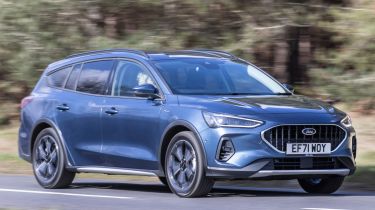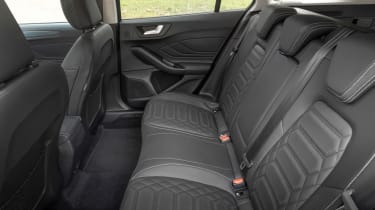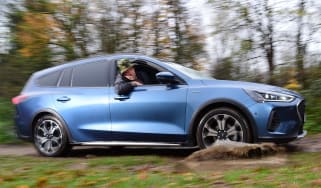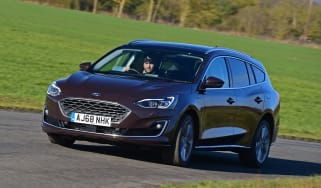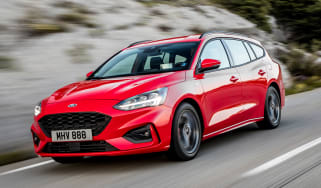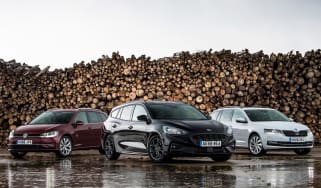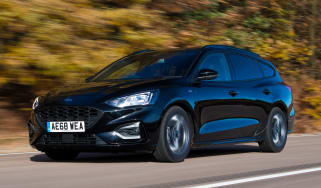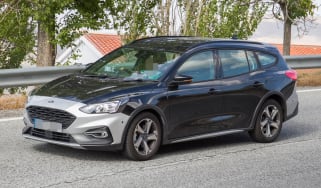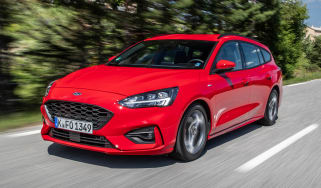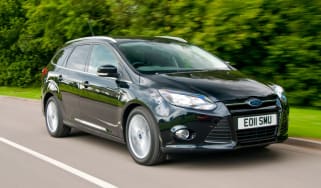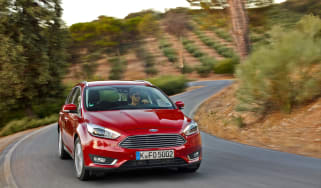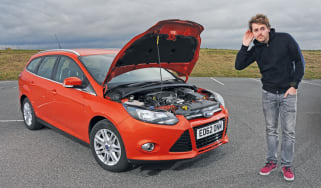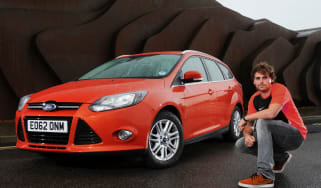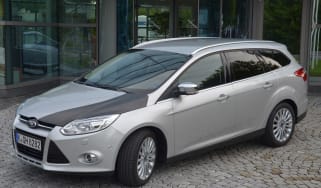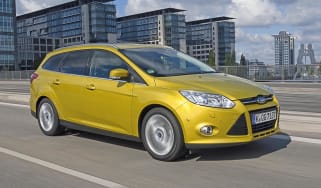Ford Focus Estate review
The estate option adds another dimension to the fun-driving and family-friendly Ford Focus line-up

It’s a sector that’s lost out in recent years thanks to the trend for SUVs, but the Ford Focus Estate model is here to remind us that the original family-friendly format still has a lot to offer. More handsome and stylish than you might expect, the Focus Estate combines practical load-lugging ability with a fun-to-drive factor you’ll struggle to find in a top-heavy compact SUV or MPV.
With solid build quality, loads of efficient engine and gearbox options plus trim levels to suit every pocket, it’s only the fickle finger of fashion that stands between the Focus Estate and soaring sales.
About the Ford Focus Estate
The Ford Focus has been a staple of the European car market for twenty-odd years, and an estate variant has always been a part of its success story.
We’re now up to the Mk4 Ford Focus Estate, and the post-facelift version at that. In 2021 Ford refined its offering with sharpened looks, the latest SYNC4 infotainment system, a range of 48-volt mild-hybrid engines and some clever updates to the load area of the estate designed to make it even more user-friendly.
You can buy a Focus as a regular five-door hatch if you don’t need the full load-lugging capacity of the estate model, but for just over £1,000 the boot-space upgrade from 375 litres to 575 litres will seem like a sound investment to many buyers.
Used - available now

2020 Ford
Focus
24,525 milesAutomaticPetrol1.0L
Cash £14,599
2023 Ford
Focus
18,635 milesManualPetrol1.0L
Cash £15,699
2016 Ford
Focus
52,520 milesAutomaticPetrol1.6L
Cash £6,995
2021 Ford
Focus
24,596 milesManualPetrol1.0L
Cash £14,725The trim level range is the same as for the hatchback Focus with Trend opening proceedings followed by the popular Titanium models, sporty ST-Line and the Active spec. The Active cars feature a raised ride height and pseudo-SUV styling with protective cladding around the wheelarches. They are an effort to counter the lure of all those fashionable SUV options that have been stealing estate car sales in recent times.
Above the entry level Trend specification there is also the option to add the Vignale pack to your Ford Focus Estate. Vignale used to be a standalone trim level but no longer. The resulting Titanium Vignale, Active Vignale and ST-Line Vignale models give a more premium look and feel to the Focus with improved materials in the cabin and styling tweaks outside, including bigger wheels. All of which only leaves the hot hatch ST model to serve-up the Focus Estate’s most focused driving experience.
The engine range tops out with the four-cylinder, 276bhp 2.3-litre EcoBoost unit in the ST, but the main focus of the modern range is the more restrained three-cylinder 1.0-litre EcoBoost powerplant. This is available in a base 123bhp form with a six-speed manual gearbox or with 48-volt mHEV mild-hybrid technology and either 123bhp or 153bhp.
With the hybrid engines there’s the choice of six-speed manual or seven-speed Powershift automatic transmissions, the latter being a DCT dual clutch arrangement. The only other option currently available is the four-cylinder 118bhp 1.5-litre EcoBlue diesel that comes exclusively with an eight-speed torque converter automatic controlled by a rotary selector instead of a lever.
Ford has always offered two different suspension set-ups with the Mk4 Focus with more powerful versions getting multi-link rear suspension and the lesser engined versions getting a torsen beam. These days, all the Focus Estates have the multi-link setup and the five-door hatches get the cruder option - with the exception of the Ford Focus ST hot hatch.
The SUVs may have taken over the car market but there’s still a lot of life left in the estate car sector, and the Focus Estate faces an array of highly competitive rivals. The list includes the Hyundai i30 Tourer, SEAT Leon Estate, Skoda Octavia Estate and the Volkswagen Golf Estate. These cars present a lower-riding alternative to mid-size SUVs like the Peugeot 3008, SEAT Ateca, Nissan Qashqai and Skoda Karoq.
Engines, performance and drive
The Ford Focus Estate is the first choice for enthusiastic drivers, as it shares the class-leading handling characteristics of the hatchback version. In fact, the two have different rear suspension set-ups but you’ll struggle to tell them apart from the driving seat.
The estate uses a multi-link rear suspension set-up that’s more sophisticated than the twist beam configuration in the mainstream five-door hatchback models, this independent rear end being configured more like that of the Focus ST hot hatch. The Active models also get a ride height increased by 30mm for a little extra off-road ability and the ST-Line models sit 10mm lower than standard on their sports suspension for a slightly livelier feel.
Crisp electrically-powered steering and an agile chassis mean the car responds nimbly to changes of direction in all its various forms and is easy to position on the road. The ride quality is supple over all but the sharpest of bumps and successfully takes the edge off even these. There’s no real ride and handling disadvantage to choosing the Active variants, maybe a degree of extra body roll in corners, and the ST-line models are barely any less comfortable, both testament to the skill of Ford’s engineers in setting up the car.
The manual gearbox is pretty slick, and the eight-speed torque converter auto in the diesels is generally a smooth performer. The seven-speed Powershift dual-clutch automatic is similarly smooth but there’s no option to shift through the gears yourself via the shift lever and only ST-Line models get steering wheel shift paddles. In the end, it’s not quite as seamlessly impressive as the DSG box in rival VW Golf models.
All Focus models get selectable drive modes that adjust the parameters of the electronic power steering, the throttle pedal and the automatic gearbox (if the car has one) according to Normal, Sport and Eco modes. The Active models add Slippery and Trail modes in line with their mild off-roading remit.
Engines, 0-60 acceleration and top speed
There’s a strong range of petrol and diesel engines on offer with the Ford Focus Estate. Petrol power comes from the 1.0-litre EcoBoost engine, available either in standard 123bhp form, or two versions with 48v mild-hybrid technology producing 123bhp and 153bhp. The lower-powered cars use either a six-speed manual, or eight-speed auto transmission. The 153bhp version is offered with the manual 'box or the seven-speed dual-clutch auto and is the quickest in the core 1.0-litre range, achieving 0-62mph in 9.0s as a manual or 8.4s with the automatic gearbox. Top speeds are 131mph and 129mph respectively.
We’re used to Ford’s Ecoboost three-cylinder engines turning in levels of performance that belie their size by now but it’s worth re-asserting that they have plenty of performance for the Focus. Buyers should not be put off by the lack of cubic capacity. There’s also that slightly coarse, engine note that adds a bit of character to proceedings under hard throttle. It means these aren’t the most refined petrol engines in the class but noise is far from intrusive when cruising.
The sporty 2.3-litre Focus ST Estate model delivers its 276bhp via a six-speed manual or eight-speed auto gearbox and manages the 0-62mph sprint in 5.8s regardless of transmission. The top speed is 155mph.
That leaves just the 1.5-litre EcoBlue diesel with 118bhp, now that the 2.0-litre diesel is no longer offered. Here, there’s the same choice of six-speed manual gearbox or eight-speed auto as you get with the ST. The manual variant can have 0-62mph dispatched in 9.8s whereas the auto takes 10.6s. Top speeds are 122mph and 120mph respectively.
MPG, CO2 and running costs
The Ford Focus has gone hybrid in a bid to further lower its running costs but there are no plug-in models, just 48-volt mild-hybrid versions of the 1.0-litre Ecoboost engine badged up as mHEV (Mild Hybrid Electric Vehicle). All of the Ecoboost engines also feature cylinder deactivation that can shut down a cylinder to save fuel when the engine isn’t under high loads.
The system replaces a standard alternator with a belt-driven starter/generator motor that means energy otherwise lost as the car slows can be recovered and stored in a battery. As well as helping to power the car’s electrical systems, the motor also gives a torque boost to improve performance or reduce the amount of work the petrol engine is asked to do as required.
The result is some respectable fuel economy numbers across the range, although the mild hybrid version of the 123bhp 1.0-litre Ecoboost is hardly any more efficient than the entry level version of that unit without hybrid assistance. That entry-level engine is rated at 47.1 to 52.3mpg on the WLTP combined cycle with the manual gearbox. The mild-hybrid with the seven-speed Powershift auto gets 47.9 to 52.3mpg and the more powerful 153bhp Ecoboost gets 51.4 to 54.3mpg as a manual or 49.6 to 53.3mpg with the auto. CO2 emissions for these cars are similarly close, all between 116 and 135g/km.
The 1.5-litre Ecoblue diesel is the most efficient, rated between 62.8mpg and 67.3mpg as a manual and between 56.5 and 61.4mpg with the eight-speed auto. Emissions are 110 to 131g/km. Opt for the Focus ST hot hatch and there’s a predictable drop to around 35mpg with emissions of around 183g/km, regardless of gearbox selection.
Insurance groups
Insurance groups for the mainstream Ford Focus Estate models range from around group 13 for the entry-level Trend to Group 16 for a pricier 153bhp Ecoboost ST-Line Vignale. Active models sit at a similar level and the ST performance versions are in group 27.
Depreciation
In spite of all its qualities, the blue oval badge on the nose of the Focus Estate has traditionally made it less sought-after on the second-hand market than, say, a VW Golf. However, depreciation isn't as rapid as you might think, with data suggesting the Focus Estate should hold onto an average of over 55 per cent of its original value after three years and 36,000 miles.
It’s noticeable that the Active variants hold their value less well than the conventional ones, largely sitting in the 46 to 50 per cent retained value range. The ST versions hold on to around 53 per cent while Titanium and ST-Line models with the Vignale pack keep 56 to 58 per cent of their value.
By way of comparison, the VW Golf Estate typically sits a few percentage points higher model for model in the 49 to 60 per cent range.
To get an accurate valuation on a specific model check out our free car valuation tool...
Interior, design and technology
While the previous generation Focus lacked a bit of pizazz on the style front, Ford’s designers upped their game with the fourth-generation car to make it more individual and eye-catching. The midlife facelift of 2021 brought LED headlights to all models in the range while the front grille and bumper area are altered according to trim level, giving the different variants a more distinctive look.
Inside, the Focus Estate shares the hatchback’s clean and uncluttered dash, as well as a ‘floating’ tablet style touchscreen of either 8” or 13.2” depending on the trim level. The quality of the interior fit and finish is good for the family hatchback class, with soft-touch materials and with attractive metallic finishes making the cabin a welcoming environment. There are harder plastics to be found lower down on the doors and the centre console.
Entry-level Trend models feature a good level of standard equipment but, crucially, get the older 8.0-inch touchscreen with Ford’s SYNC 3 operating system. All other models get the 13.2” screen with the newer, and better, SYNC 4 software.
Aside from that, all models get Apple CarPlay and Android Auto connectivity, selectable driving modes, air conditioning, cruise control with a speed limiter, a Quickclear heated front screen and LED headlights. As well as the improved infotainment system, Titanium models add alloy wheels, LED rear lights, power folding mirrors, climate control, keyless entry and keyless start.
The ST-Line variants get 17” wheels, tinted glass, sports suspension and other styling upgrades. Active variants, meanwhile, feature subtle body cladding around the sills and wheel arches, a raised ride height and some extra off-road driving modes. You can add the Vignale pack to any trim level except Trend and that gives you the full 12.3” digital instrument cluster in place of analogue dials with a small display between them, as well as various trim upgrades.
The flagship Ford Focus ST cars include 19-inch wheels, a unique bodystyling kit with rear spoiler, alloy finish pedals and ST sports suspension.
Sat-nav, stereo and infotainment
Ford's SYNC 3 infotainment system is still on the entry-level Focus Estate Trend models in combination with the 8” touchscreen but the 13.2” SYNC 4 screen on all the other versions is much more impressive.
Ford has crammed the majority of the car’s minor controls into the SYNC 4 system with only a few shortcuts and the volume control getting physical buttons. For the most part it works very well with a fixed bar at the bottom of the screen for climate control settings, which means adjusting the fan speed and temperature is just a matter of a quick press and a swipe.
The menu system is intuitive, the important button areas are large enough to press on the move and the large screen is split so it can show the status of different functions at the same time. The system can receive software updates wirelessly as well.
Practicality, comfort and boot space
Jump into the front seat of any new Ford Focus, and without looking over your shoulder you’ll never know whether it’s an estate or hatchback – up front the two variants are identical. That means you get a great driving position with plenty of adjustment, and a slim centre console to maximise available space for people.
There’s a minor difference for rear seat passengers as the arc of the estate’s roof means they get more headroom, but unsurprisingly it’s the boot space where the real advantages are to be found.
Storage in the front of the car is good for the class. There are door pockets, a glovebox that isn’t entirely occupied by the manual, and a deep bin under the centre arm rest. The cup holder arrangement is adjustable to fit cups of various sizes and there’s a large shelf below the central screen with a charging mat for your phone.
Leg room, head room & passenger space
The old Mk3 Focus always suffered with cramped rear accommodation, but the Mk4 model – hatch or estate – benefits from extra length in the wheelbase. As a result, six-footers can now travel comfortably in the rear of the car, while a flat floor makes the centre rear seat more usable too.
Space in the back really is very good with leg room for two adults plentiful, even behind a tall driver. You could sit three kids across the back of the car but the middle seat is going to be narrow for an adult on a long journey. Estate headroom is better than in the hatch as well.
Boot space
Careful suspension design has helped to maximise the space available in the Focus Estate’s luggage compartment, which is among the largest in the class. Even with the rear seats in use you get a massive 575-litres of load area, which compares well to just 443 litres in the hatch, although you get 611 litres in the Volkswagen Golf Estate.
If you fold the rear seats down and you’re rewarded with a flat load space with a huge 1,620 volume. The 60/40 split seat backs can be released with catches on the seat shoulders or via levers in the boot itself. On the latest Focus Estate models there’s an adjustable boot floor that can fold up to partition the boot into two areas, the first having a rubber floor to store wet or muddy items.
Reliability and safety
There’s a lot of advanced technology in the latest Focus line-up, and some of the most impressive kit is designed with safety in mind. The Focus hatch scored an impressive five stars in the Euro NCAP crash tests in 2018 and while the tests have grown tougher in the years since, the Focus has enhanced its arsenal of safety kit.
All models have Lane-Keeping Assist and Pre-Collision Assist with an Autonomous Emergency Braking feature that can also detect pedestrians and cyclists. The standard LED headlights have Automatic High Beam Control and a function that gives a wider spread of light for low speed manoeuvres.
The Driver Assist Pack adds various extra safety features including Traffic Sign Recognition and there’s an advanced Blind Spot Information System on the options list that scans adjacent lanes for vehicles, and can be adjusted to compensate if you’re towing a trailer.
Ford has made some positive strides on the reliability front but finished a lowly 25th out of 30 manufacturers in our 2022 Driver Power brands poll, a similar position to the one it’s occupied for a few years. The Focus itself didn’t appear in the 2022 model survey but finished 72nd out of 75 cars in Driver Power 2021.
Warranty
Standard warranty cover is three years and 60,000 miles, but you can pay more to extend up to five years and 100,000 miles.
Servicing
Expect to pay around £500 for the first three years of maintenance, including two routine stops for servicing.

